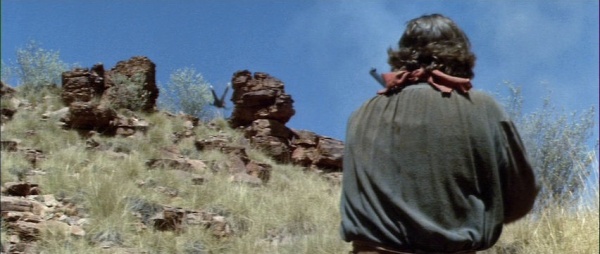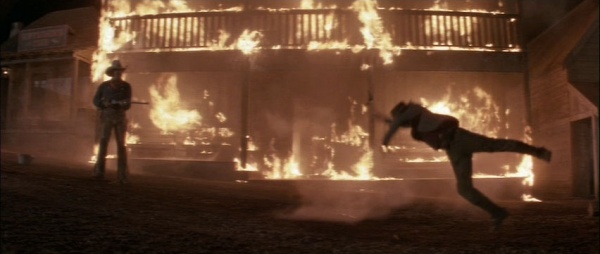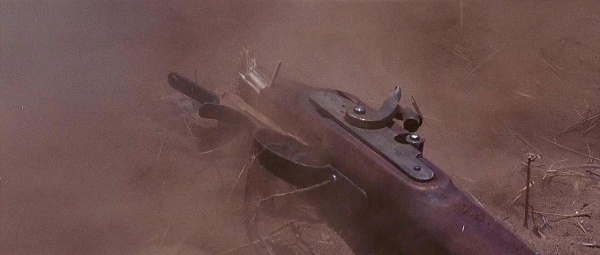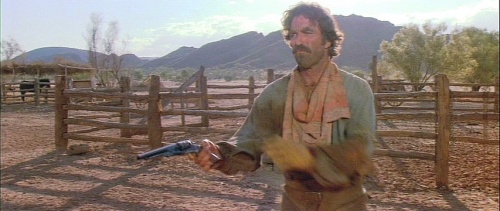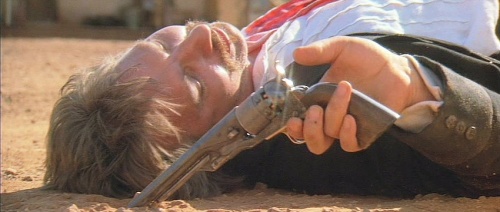| If you have been locked out of your account you can request a password reset here. |
Talk:Quigley Down Under
Hollywood Wonders
I figured these shots would take up too much room on the page, but here is what the the Sharps rifle can do with the help of Hollywood and its physics denying ways. Since the rounds are not moving at the speed of light and aren't as heavy or heavier than the person being shot, this is commonly known as impossible, despite what some "rocking chair commandos" may tell you.
Yeah but they look cool. --Jcordell 17:29, 26 August 2009 (UTC)
There are several other things that are impossible about this movie. The setting of the movie is the year 1860.
Says who? Where and when is that stated in the film?
Did you watch the movie? It isnt an 1874, it was converted from paper cartridges, to self contained metalic cartridges. -Blaise
Yes, I watched the movie. And the company that built the gun (and two others) used by Selleck in the movie is Shiloh Sharps Company from Big Timber, Montana. They used their model 1874, not a percussion rifle converted to an metallic cartridge (their model 1863 rifle). Shiloh Sharps offers a Model 1874 Quigley rifle to this day on their website. Here's a note from a guy who talked to the Shiloh Sharps people who verified to him that it was an 1874 model in the movie, scroll down to the last post by Michael Hacker on January 13, 2007: http://www.survivalarts.com/archives/000238.html I'll say it again, the gun(s) Selleck used in the movie was/were Model 1874 Sharps. And for historical purposes, there were NO cartridge conversions of Sharps rifles in 1860-1874, no one made the brass for this, no one did the conversions. Quigley would have been carrying a paper cartridge rifle. I realize the script calls for Quigley to have somehow found a gunsmith who magically makes brass center-fire cartridges in an age when the only ones, and they were few and far between, were small caliber rimfires, and then could also magically convert the rifle to fire these. Simply stating that this is a premise of the movie doesn't make it doable in the real world of the time, or historically accurate, anymore than the cartridge conversion that some Texas gunsmith does to Selleck's revolver in another of his revisionist westerns, Last Stand At Saber River which is set in 1865 (not to mention the The Good, The Bad and The Ugly among others). So there was no one on the Australian continent who could shoot accurately at distance? They never heard of the Whitworth rifle, first produced in 1857 that could make head shots at over 1000 yards? Marston has to send fliers around the world to find someone who can shoot accurately at 800-1000 yards? Well maybe so, since the script was written so that none of his hired hands could hit the broad side of a barn with a revolver except that kid that finally shot Quigley in the leg. Frankly the whole premis of this movie is preposterous, why would Marsten not simply kill Quigley at his ranch instead of the whole melodramtic, idiotic "take him two days journey away in a wagon and the let Australia kill him". Huh? Shoot the guy on the ground at your feet and end your problem then and there. And then to top off the stupidity, let some henchman take the rifle and the ammunition with him, instead of Marsten keeping it as a prize as he undoubtedly would have. And then the wagon driver takes off instead of getting off the wagon and shooting Quigley dead after his partner is knifed (apparently they're all too stupid to search him for hidden weapons too). This kind of insanity continues all the way through, culminating in the kid shooting Quigley in the leg and then not blowing Quigley's brains out then and there when he steps on the rifle; and collecting the 200 pounds reward from Marsten. No, they drag him for God knows how long behind a horse, which of course doesn't kill him nor even tear up his clothes. Then Marsten doesn't kill him, but has a quick draw contest, and Quigley is so unaffected by being dragged for miles behind a horse that he outdraws three guys, even though he doesn't like handguns, good Barbera Boxer-style liberal that he is, and hasn't even been able to put his hands on one for the 3 month voyage and his time in Australia before he wins the gunfight. Yet he outdraws three guys who use and practice with a handgun all the time. Yeah, I was able to suspend disbelieve (rolling eyes here).
Then there is the fact that the so-called Model 1858 Remington New Army did not begin production until at least 1860 (the Remington-Beals Army & Navy 1860-62), and the 1861 Army & Navy beginning in 1862; so it could not possibly have been in the United States, let alone Australia, in 1860, and if it's after 1860, the manufacturers are filling military contracts first and foremost for Lincoln's War. The Colt 1860 Army did not begin production until 1860, so considering tooling up, production, assembly, testing and inspection of the guns before they were sent to market, first fulfilling military contracts, there was again no way they could have been in Australia in 1860.
Then there is Matthew Quigley himself. We're supposed to believe that a Wyoming frontiersman in 1860 doesn't like handguns and doesn't carry one, that he'd go halfway around the world to a foreign country without asking or knowing exactly what the shooting job entailed (someone would believe a guy would hire a dude and pay for him to come halfway around the world just to shoot feral dogs??), and when he finds out he would be, in effect, so in tune with John Brown's views that he would go to war with his own people and side with black aborigines against them. Now keep in mind that it had been a year or less since John Brown had been executed for what today would be labeled "terrorist activities" and he would be called a terrorist. Brown led a raid on a U.S. military arsenal at Harper's Ferry, Virginia (this was when the six western counties were still part of the state of Virginia) the goal of which was to lead a slave rebellion and basically overthrow the government of the United States. He was captured, tried for treason and hanged for leading what the government today has made a dirty word, militia, and Brown and his group were in effect, "insurgents". And Matthew Quigley, Wyoming frontiersman who would have had to have had his share of run-ins with hostile Indians, is supposed to be a spritual kinsman of John Brown? I don't think so, not in the 1860's. This movie basically makes Tom Selleck's character into a 1968 liberal Democrat from New York. Bleech.
This is a great debate, but why don't you guys actually have a signature? What are you all afraid of? Also I just watched the movie today and nowhere does it say anything about it being 1860. I just figure it's the late 1860's or even the early 1870's. It's still agood movie even if it isn't an accurate historical portrayl of the hero. --Jcordell 00:42, 21 November 2009 (UTC)
Is there some great significance to "having a signature"? If it's after Lincoln's War or in the 1870's, then why is no one carrying a Henry, a Goldenboy Winchester or a Model 73, or even a Spencer? No cartridge conversion revolvers either, (the first one of those was the Remington New Model Army in 1868 converted to .46 Rimfire, according to Cimarron's website, and they paid a royalty to Smith & Wesson who owned the Rollin White patent on bored through cylinders; S&W themselves didn't start making bored through cylinders until nearly two years later with the Model 3 and Colt didn't start making cartridge conversions or doing it on customers guns until, if memory serves, 1871). These guys are armed with Hawkins Plains rifles (percussion) and even the shipping clerk at the end has a single shot percussion pistol under the counter (oh for the days of no passports with RFID chips, fingerprinting and facial recognition software!). I also found it odd that no one in the movie has a shotgun, ranchers and cattle herders in the Outback country would certainly have found a scattergun quite useful, especially with the threat of feral dogs.
- It could be the film just decided to depict Australia as behind with the most modern weaponry, and it could be Marsten and his men brought what they had when they first came to Australia and never rearmed. - Gunmaster45
- Actually, S&W started making guns under the Rollins-White patent in 1857 with the Model 1 in .22 Short, followed up by the Model 2 in .32 RF in 1861 and the Model 1 1/2 small frame .32 RF in 1865. They didn't start making large bore guns until the Model 3 American in 1870, but they were certainly making bored through cylinders beforehand. - Nyles
- or it could be that they could use black powder revolver because get your hands on modern bullets would be difficult with towns being far away. so they could make there own bullets and gun powder.
- The guy at the front, will you stop your moaning, like a little baby, shut up, and just enjoy the movie, instead of dissecting it for EVERY little thing that could possibly be inaccurate. Also the date is confirmed to be 1860, at least that's the given date on the back of my VHS copy. - 1morey
Signature Significance
Unknown
Is there some great significance to "having a signature"?
Having a signature is polite. It means you bothered to make a page so when you contribute or edit things we know who did it. It's pride of ownership.You've filled out this discussion page and yet nobody knows who you are. What's your background? Obviously you have knowledge about the various firearms of the Civil War era. Why is that?Don't be such a stranger. --Jcordell 16:29, 28 November 2009 (UTC)
Was there anything similar to Quigleys Shiloh Sharps 1874 Long Range back in 1868?
I'm writing a story based in 1868 that calls for the protagonist to have something akin to Quigley's 1874, but the time period of the story is not flexible and must take place in 1868, so I was wondering if a gun like his existed back then. One that had things like double-triggers and adjustable rear sights. Thanks in advance.
Just don't tell anyone the date, it can take place in 1866, but if you're the only one who knows then there's no problem with a few historical inaccuracies. Besides, you could always handwave it and say it was custom built, not a production gun(or maybe an early prototype). Lastly, I'd worry more about cultural historical inaccuracies than any gun anachronisms. Face it, guns are tools, and you shouldn't bend a story just to fit its props. --Mr-Jigsaw 05:48, 2 August 2010 (UTC)
- There were many models of Sharps rifles made before 1874, so a Sharps model in 1868 would still work, it'd just have to be a percussion gun. Write something in like a Sharps 1865 long barrel percussion rifle fitted with a full-length scope. Say it's a sharpshooter's rifle kept from the Civil War. - Gunmaster45
- Although I agree with Mr. Jigsaw, there certainly were target rifles available in 1868, but most were muzzle loaders. Here's an example of an American target rifle of the era: http://www.gatling-gun.com/SchuetzenTargetRifle.htm. Here's a breakdown of Confederate sharpshooter rifles, including the famous British Whitworth: http://www.cfspress.com/sharpshooters/arms.html. There was also the US 2nd Sharpshooters special-order Sharps 1859 infantry rifle, which had set triggers and was a percussion breechloader. It could have been fitted with a Vernier sight, or even an early scope, with relatively minor modifications. - Nyles
- There were many models of Sharps rifles made before 1874, so a Sharps model in 1868 would still work, it'd just have to be a percussion gun. Write something in like a Sharps 1865 long barrel percussion rifle fitted with a full-length scope. Say it's a sharpshooter's rifle kept from the Civil War. - Gunmaster45
- Thanks everyone, this really helps.
Hawken
That's not a Hawken in the above picture. Looks more like an Enfield that the soldiers were carrying.
The triggerguard is different from the Thompson Center Hawken, but it still is a Plains type rifle (haven't seen the movie in a while, so I don't remember).
--Markethunter 21:31, 23 September 2010 (UTC)
(Moved from Main Page)
Elliot Marston (Alan Rickman) uses a Colt 1860 Army .44 caliber as his personal sidearm. He refers to it as the Army revolver and has much respect for its maker, Colonel Samuel Colt. He gives his second one to Quigley in the final duel, thinking he is bad with revolvers based on how he said he never had much use for one. When Quigley defeats him and his two men he says, "I said I never had much use for one. Never said I didn't know how to use it." He pockets the revolver, then realizing he found a reason to use one.
So....when do you guys think this is supposed to be set?
Usually, Western films (or films set in other countries of the same time period) usually are given a date, or information through characters throw hints to when the film is set. Promotional material for this film, states 1860, which would make most of the guns anachronistic.
However, there's a lot of problems with this. Marston and Quigley talk about Samuel Colt (who passed away in 1862) and Bill Hickok (who didn't become famous until the late 1860s). It is also stated that Quigley was in Dodge City. I'm assuming this is referencing the Dodge City War (which took place in 1883, and the town itself was not founded until 1872.). Meanwhile, the British soldiers are armed with the Enfield P56, which again, designates the time period being the early 1860s. The British soldiers' uniforms also date the film to the 1860s. I'm assuming the film is set somewhere between the late 1860s to early or mid 1870s, seeing as Australians probably were a bit behind in the acquirement of new technology, though if this is the case, the British military would be seen with Home Service helmets and either Snider-Enfields or Martini-Henrys. (And I doubt the Queen would have allowed any military presence to not be on par with the rest of the Empire's military. - User:1morey October 5, 2016 9:53 PM (EST)
- I think the best thing to do is chalk up the little technical errors (such as the reference to Dodge City) to less than stellar historical research on the part of the writer(s). I figure the movie is set in the late 1860's or possibly 1870. I've always liked the year 1870. As far as the British soldiers.....well the British Empire was large and it could take months for new equipment to reach far flung garrisons - especially garrisons where things were not as intense as say on the Northwest Frontier where a garrison not only had to worry about the local tribes but the Russians. A matter of priority. A garrison in Western Australia functioning as a police force is going to be lower on the list than the regiment preparing to ship out to quell restless natives in India or engage the Russians in the Crimea. I know I'm stretching but the movie looks good, --Jcordell (talk) 22:52, 5 October 2016 (EDT)
https://www.youtube.com/user/Iraqveteran8888/videos made a video
Iraqveteran8888 made a video about this film here
https://www.youtube.com/watch?v=A7tneYzIFQw
and goes into great detail about one of the weapons in this film
hopes this helps
--Seekerdude (talk) 15:12, 7 October 2016 (EDT)
https://www.youtube.com/user/Iraqveteran8888/videos made a video
Iraqveteran8888 made a video about this film here
https://www.youtube.com/watch?v=A7tneYzIFQw
and goes into great detail about one of the weapons in this film
hopes this helps
--Seekerdude (talk) 15:14, 7 October 2016 (EDT)
The Year? It's a Movie!
This from Wikipedia helps a bit:
John Hill first began writing Quigley Down Under in 1978, and both Steve McQueen and Clint Eastwood were considered for the lead, but by the time production began in 1980, McQueen was too ill and the project was scrapped.[2] In the mid-1980s Tom Selleck heard of it and UAA got involved; the film was almost set up at Warner Bros with Lewis Gilbert as director but it fell over during pre-production. Simon Wincer then became director, who felt a good story had been ruined by numerous rewrites from people who knew little about Australian history, so he brought on Ian Jones as writer. They went back to the original draft, re-set it from the 1880s to the 1860s and made it more historically accurate.[3]
So, they moved the timeframe. Would not be unusual that at the 1880s range one of the rewrite writers knew his shit, then they kept all the cool-sounding gun details when they moved it and no one else noticed/cared.
Also:
The firearm used by Quigley (Selleck) is a custom 13.5 pound (6 kg), single-shot, 1874 Sharps Rifle, with a 34-inch (860 mm) barrel.[4] The rifle used for filming was a replica manufactured for the film by the Shiloh Rifle Manufacturing Company of Big Timber, Montana.[5] In 2002 Selleck donated the rifle, along with six other firearms from his other films, to the National Rifle Association, as part of the NRA's exhibit "Real Guns of Reel Heroes" at the National Firearms Museum in Fairfax, Virginia.[6]
Anyone near the NRA museum? Someone should talk to them, get some photos of the actual film rifle. --Shoobe01 (talk) 18:43, 15 October 2018 (EDT)
